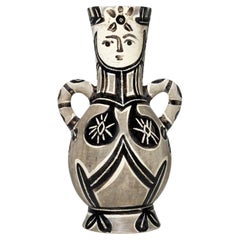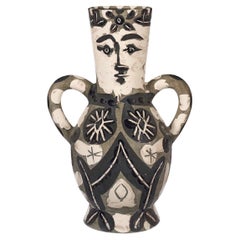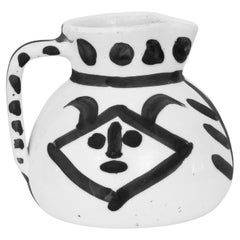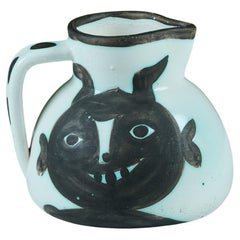Kahan Gallery Vases
2
2
2
2
2
2
2
2
Height
to
Width
to
2
2
2
2
Pablo Picasso Vase Deux anses hautes (A.R. 213) - The Queen Madoura Ceramic Vase
By Pablo Picasso
Located in New York, US
Picasso's Vase Deux Anses Haute (Ramie 213) is a unique and iconic ceramic that reflects the artist's inventive approach to form and function. Created in 1954 as part of Picasso's co...
Category
Mid-20th Century French Modern Vases
Materials
Ceramic
Pablo Picasso Vase Deux anses hautes (A.R. 141) The King, Madoura Ceramic Vase
By Pablo Picasso
Located in New York, US
Picasso's Vase Deux Anses Haute (Ramie 141) is a unique and iconic ceramic that reflects the artist's inventive approach to form and function. Created in 1954 as part of Picasso's co...
Category
Mid-20th Century French Modern Vases
Materials
Ceramic
Related Items
Pablo Picasso Ceramic Pitcher Tetes Visages Editions Picasso Madoura
By Pablo Picasso
Located in Chicago, IL
Madoura turned pitcher of white earthenware clay with decoration by Pablo Picasso black and white drawings. This work is stamped with the 'MADOURA PLEIN FEU' and 'EDITION PICASSO' po...
Category
Vintage 1950s French Mid-Century Modern Decorative Dishes and Vide-Poche
Materials
Ceramic
Pablo Picasso Pichet Têtes Pitcher
By Pablo Picasso
Located in Los Angeles, CA
Earthenware pitcher by Pablo Picasso 1950's edition. The pitcher features two different figures on each side of the pitcher, in both a black oxidized and white glaze.
Dimensions
6.5...
Category
Mid-20th Century Unknown Expressionist Pitchers
Materials
Earthenware
'Pichet Espagnol' from the Madoura Pottery 'AR 245' by Pablo Picasso '1954'
By Pablo Picasso
Located in London, GB
'Pichet Espagnol' ceramic piece from the Madoura Pottery (A.R. 245) by Pablo Picasso (1954). A fired, unglazed ceramic pitcher in the form of a stylise...
Category
Vintage 1950s French Modern Abstract Sculptures
Materials
Ceramic
$62,223
H 8.67 in W 9.85 in D 4.73 in
Pablo Picasso Ceramic Dish Editions Picasso Madoura Bird And Sun 1952
By Madoura, Pablo Picasso
Located in Chicago, IL
Pablo Picasso Oiseau Bird with Sun dish editions Picasso Madoura France. Circa 1952. Impressed with mark to underside Madoura Plein Feu edition Picasso and also with edition Picasso....
Category
Vintage 1950s French Mid-Century Modern Decorative Dishes and Vide-Poche
Materials
Ceramic
Pablo Picasso Signed Limited Ed. Madoura Pottery Pitcher Têtes , 1956 A.R. 368
By Pablo Picasso, Madoura
Located in Studio City, CA
A wonderful, original Mid-Century Modern Madoura pottery pitcher/vase by renowned Spanish artist Pablo Picasso titled "Têtes (Heads)". The piece features two hand painted images of ...
Category
Vintage 1950s French Mid-Century Modern Vases
Materials
Ceramic, Earthenware, Pottery, Paint
$12,500
H 5 in W 5.5 in D 6 in
Pablo Picasso Signed Limited Madoura Pottery Chouetton Owl Vase A.R. 135, 1952
By Pablo Picasso
Located in Studio City, CA
A wonderful, original Mid-Century Madoura pottery vase by renowned Spanish artist Pablo Picasso titled "Chouetton (Young Wood Owl)". The work, which features two distinct owl faces,...
Category
Vintage 1950s French Mid-Century Modern Vases
Materials
Ceramic, Pottery, Earthenware
$24,500
H 9.75 in Dm 4.75 in
Pablo Picasso Glazed Earthenware Têtes Pitcher
By Pablo Picasso
Located in Bradenton, FL
Pablo Picasso (Spain, 1881 - 1973) Glazed Earthenware "Tètes" Pitcher. The Têtes pitcher was created in Vallauris, France in late 1940's, early 1950s. Pitcher is known for its distin...
Category
Early 20th Century French Modern Vases
Materials
Earthenware
Pablo Picasso Edition Madoura Vase pitcher "Woman " 1955
By Pablo Picasso
Located in Paris, FR
"Woman" turned Pitcher (with 3 pearl necklaces)
White earthenware clay , decoration in engobes and engraved by knife.
Alain Ramié catalogue AR301 page 155
Originale Edition Atelier M...
Category
Vintage 1950s Ceramics
Materials
Ceramic
Pablo Picasso Signed Limited Ed. Madoura Pottery Bowl Oiseau à la Huppe A.R. 173
By Pablo Picasso
Located in Studio City, CA
A wonderful, original Mid-Century Modern Madoura pottery ashtray/bowl by renowned Spanish artist Pablo Picasso titled "Oiseau à la huppe (Bird with tuft...
Category
Vintage 1950s French Mid-Century Modern Decorative Bowls
Materials
Ceramic, Earthenware, Pottery, Paint
$8,500
H 1.75 in Dm 6.25 in
Pablo Picasso, Hibou, 1954, Pichet tourné, édition Picasso, Madoura
By Pablo Picasso, Madoura
Located in Nice, Cote d' Azur
Pablo Picasso
Hibou
1954
Pichet tourné
H. 24,5 cm. Larg 13 cm
R.A terre de faience blanche, décor à l'oxyde sur émail blanc
Bleu
Tiré à 500 exemplaires
Edition Picasso, Madoura.
Répe...
Category
Vintage 1950s French Modern Figurative Sculptures
Materials
Ceramic
Picasso Ceramic Pitcher
By Pablo Picasso
Located in Los Angeles, CA
Ceramic Picasso Pitcher
Tetes -1956
5” diameter x 6” tall
Pablo Picasso (1881-1973)
Earthenware pitcher white, oxidized paraffin decoration, black and white enamel,
“Edition Picasso...
Category
Vintage 1950s Vases
Materials
Ceramic
Engraved Face Plate by Pablo Picasso for Madoura
By Pablo Picasso, Madoura
Located in Chicago, US
Engraved Face Plate by Pablo Picasso for Madoura.
Category
Vintage 1940s French Mid-Century Modern Decorative Bowls
Materials
Earthenware



